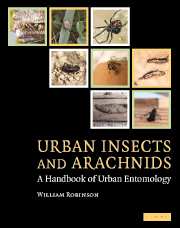Book contents
- Frontmatter
- Contents
- Preface
- Part I Urban entomology
- Part II Insects in the urban environment
- 4 Blattaria
- 5 Coleoptera
- 6 Collembola, Dermaptera
- 7 Diptera, Ephemeroptera
- 8 Hemiptera, Homoptera
- 9 Hymenoptera
- 10 Isoptera
- 11 Lepidoptera
- 12 Mantodea, Neuroptera
- 13 Orthoptera, Phasmatodea
- 14 Phthiraptera
- 15 Plecoptera, Psocoptera
- 16 Siphonaptera
- 17 Thysanoptera, Thysanura, Trichoptera
- Part III Other arthropods in the urban environment
- Family, genus, species index
- Index
- References
7 - Diptera, Ephemeroptera
Published online by Cambridge University Press: 06 August 2009
- Frontmatter
- Contents
- Preface
- Part I Urban entomology
- Part II Insects in the urban environment
- 4 Blattaria
- 5 Coleoptera
- 6 Collembola, Dermaptera
- 7 Diptera, Ephemeroptera
- 8 Hemiptera, Homoptera
- 9 Hymenoptera
- 10 Isoptera
- 11 Lepidoptera
- 12 Mantodea, Neuroptera
- 13 Orthoptera, Phasmatodea
- 14 Phthiraptera
- 15 Plecoptera, Psocoptera
- 16 Siphonaptera
- 17 Thysanoptera, Thysanura, Trichoptera
- Part III Other arthropods in the urban environment
- Family, genus, species index
- Index
- References
Summary
DIPTERA
Introduction
Flies are one of the most recognized pests in the urban environment. The fore wings of dipterans are developed, but the hind wings are reduced to small knobbed structures called halteres. Adult flies are active during the day, sometimes at dawn or dusk, and are usually attracted to the odors from sites suitable for larval feeding and development. The larvae are known as maggots, and although this is the primary feeding stage, it is often in a different habitat from the one visited by adults.
Domestic and peridomestic habitats attract fly species that feed as adults or larvae on decaying organic material. Many of these species came from populations in natural habitats separate from the urban environment. Food storage indoors often results in small amounts of ripe and decaying substrate that attract adult flies. Female fungus gnats and fruit flies can detect alcohols, acetic acid, and other volatile compounds from these materials, and follow the odor to an oviposition site. Dead and decaying organic matter is quickly identified as an oviposition site by adult scatopsides, sepsides, and phorids. Adults of several fly species are found indoors in the fall and winter. These include overwintering cluster flies and face flies that spend the winter in attics, wall voids, and other rooms. Chlorpoids and other small flies that occur in large numbers at windows in the fall do not overwinter, but are gathered in large numbers by prevailing winds and are carried in through open windows.
- Type
- Chapter
- Information
- Urban Insects and ArachnidsA Handbook of Urban Entomology, pp. 147 - 201Publisher: Cambridge University PressPrint publication year: 2005

